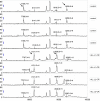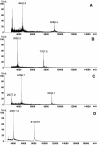Discovery and identification of potential biomarkers of pediatric acute lymphoblastic leukemia
- PMID: 19291297
- PMCID: PMC2662805
- DOI: 10.1186/1477-5956-7-7
Discovery and identification of potential biomarkers of pediatric acute lymphoblastic leukemia
Abstract
Background: Acute lymphoblastic leukemia (ALL) is a common form of cancer in children. Currently, bone marrow biopsy is used for diagnosis. Noninvasive biomarkers for the early diagnosis of pediatric ALL are urgently needed. The aim of this study was to discover potential protein biomarkers for pediatric ALL.
Methods: Ninety-four pediatric ALL patients and 84 controls were randomly divided into a "training" set (45 ALL patients, 34 healthy controls) and a test set (49 ALL patients, 30 healthy controls and 30 pediatric acute myeloid leukemia (AML) patients). Serum proteomic profiles were measured using surface-enhanced laser desorption/ionization-time-of-flight mass spectroscopy (SELDI-TOF-MS). A classification model was established by Biomarker Pattern Software (BPS). Candidate protein biomarkers were purified by HPLC, identified by LC-MS/MS and validated using ProteinChip immunoassays.
Results: A total of 7 protein peaks (9290 m/z, 7769 m/z, 15110 m/z, 7564 m/z, 4469 m/z, 8937 m/z, 8137 m/z) were found with differential expression levels in the sera of pediatric ALL patients and controls using SELDI-TOF-MS and then analyzed by BPS to construct a classification model in the "training" set. The sensitivity and specificity of the model were found to be 91.8%, and 90.0%, respectively, in the test set. Two candidate protein peaks (7769 and 9290 m/z) were found to be down-regulated in ALL patients, where these were identified as platelet factor 4 (PF4) and pro-platelet basic protein precursor (PBP). Two other candidate protein peaks (8137 and 8937 m/z) were found up-regulated in the sera of ALL patients, and these were identified as fragments of the complement component 3a (C3a).
Conclusion: Platelet factor (PF4), connective tissue activating peptide III (CTAP-III) and two fragments of C3a may be potential protein biomarkers of pediatric ALL and used to distinguish pediatric ALL patients from healthy controls and pediatric AML patients. Further studies with additional populations or using pre-diagnostic sera are needed to confirm the importance of these findings as diagnostic markers of pediatric ALL.
Figures





Similar articles
-
Discovery and identification of potential biomarkers of papillary thyroid carcinoma.Mol Cancer. 2009 Sep 28;8:79. doi: 10.1186/1476-4598-8-79. Mol Cancer. 2009. PMID: 19785722 Free PMC article.
-
Detection and identification of potential biomarkers of non-small cell lung cancer.Technol Cancer Res Treat. 2009 Dec;8(6):455-66. doi: 10.1177/153303460900800607. Technol Cancer Res Treat. 2009. PMID: 19925029
-
Detection and identification of NAP-2 as a biomarker in hepatitis B-related hepatocellular carcinoma by proteomic approach.Proteome Sci. 2008 Mar 10;6:10. doi: 10.1186/1477-5956-6-10. Proteome Sci. 2008. PMID: 18331625 Free PMC article.
-
Screening and identification of potential biomarkers and establishment of the diagnostic serum proteomic model for the Traditional Chinese Medicine Syndromes of tuberculosis.J Ethnopharmacol. 2014 Sep 11;155(2):1322-31. doi: 10.1016/j.jep.2014.07.025. Epub 2014 Jul 26. J Ethnopharmacol. 2014. PMID: 25072359
-
Application of serum protein fingerprinting coupled with artificial neural network model in diagnosis of hepatocellular carcinoma.Chin Med J (Engl). 2005 Aug 5;118(15):1278-84. Chin Med J (Engl). 2005. PMID: 16117882 Clinical Trial.
Cited by
-
Comparative proteomics in acute myeloid leukemia.Contemp Oncol (Pozn). 2012;16(2):95-103. doi: 10.5114/wo.2012.28787. Epub 2012 May 29. Contemp Oncol (Pozn). 2012. PMID: 23788862 Free PMC article.
-
Multifaceted Roles of Chemokine C-X-C Motif Ligand 7 in Inflammatory Diseases and Cancer.Front Pharmacol. 2022 Jun 28;13:914730. doi: 10.3389/fphar.2022.914730. eCollection 2022. Front Pharmacol. 2022. PMID: 35837284 Free PMC article. Review.
-
Prioritization of biomarker targets in human umbilical cord blood: identification of proteins in infant blood serving as validated biomarkers in adults.Environ Health Perspect. 2012 May;120(5):764-9. doi: 10.1289/ehp.1104190. Epub 2012 Jan 27. Environ Health Perspect. 2012. PMID: 22538116 Free PMC article.
-
Circulating Biomarkers Associated with the Diagnosis and Prognosis of B-Cell Progenitor Acute Lymphoblastic Leukemia.Cancers (Basel). 2023 Aug 20;15(16):4186. doi: 10.3390/cancers15164186. Cancers (Basel). 2023. PMID: 37627214 Free PMC article. Review.
-
Proteomic analysis reveals platelet factor 4 and beta-thromboglobulin as prognostic markers in severe acute respiratory syndrome.Electrophoresis. 2012 Jul;33(12):1894-900. doi: 10.1002/elps.201200002. Electrophoresis. 2012. PMID: 22740477 Free PMC article.
References
-
- Pui CH, Relling MV, Downing JR. Acute lymphoblastic leukaemia. N Engl J Med. 2004;350:1535–1548. - PubMed
-
- Parker SL, Tong T, Bolden S, Wingo PA. Cancer statistics, 1997. CA Cancer J Clin. 1997;47:5–27. - PubMed
-
- Cortes JE, Kantarjian HM. Acute lymphoblastic leukemia. Cancer. 1995;76:2393–2417. - PubMed
-
- Pui CH, Behm FG, Crist WM. Clinical and biologic relevance of immunologic marker studies in childhood acute lymphoblastic leukemia. Blood. 1993;82:343–362. - PubMed
-
- Pui CH. Childhood Leukemias. New England Journal of Medicine. 1995;332:1618–1630. - PubMed
LinkOut - more resources
Full Text Sources
Research Materials
Miscellaneous

